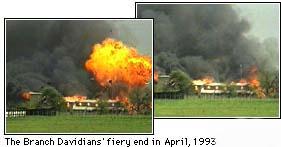WACO


A. Congress concluded: "1. The subcommittees conclude that the ATF was predisposed to using aggressive, military tactics in an attempt to serve the arrest and search warrant. The ATF deliberately choose not to arrest Koresh outside the Davidian residence and instead determined to use a dynamic entry approach. The bias toward the use of force may in large part be explained by a culture within ATF.
2. The ATF did not attempt to fully understand the subjects of the raid. The experience of Joyce Sparks, Marc Breault, and ATF undercover agent Robert Rodriguez demonstrate that persons who spent a reasonable amount of time with Koresh, even without professional training specific to persons such as Koresh, understood with some predictability the range of behaviors that might result from a military style assault on the Branch Davidians."
B. Early photos clearly show that the Davidian Compound was riddled with bullets while the ATF vehicles had no bullet holes in them.
C. The critical front door, a peice of evidence which would have shown who shot at whom was mysteriously lost while in possession of the authorities.
D. From a nearby farmhouse, the ATF trained a video camera on the Davidian compound, not just during the 51 day standoff, but for several months prior to the attack. The only tape missing is the tape from February 28th, the day of the assault.
E. The shooting review was generating statements that the ATF shot first. Again from the Congressional Report: "Documents explicitly showed that `DOJ [Department of Justice] does not want Treasury to conduct any interviews . . . [that might] generate . . . material or oral statements which could be used for impeachment' of Government witnesses, and that hopefully if such material is not gathered, `the passage of time will dim memories.' (Memorandum from Treasury Assistant General Counsel for Enforcement, dated April 14, 1993.)
Earlier, on March 1, 1993, in interview notes, the ATF's initial `shooting review' of the February 28, 1993 initial assault at which time ATF agents fired their weapons, the ATF is advised to `stop the ATF shooting review because ATF was creating Brady material.' (Note: `Brady' material is evidence that would tend to establish innocence or which could be used in mitigation of guilt.)
In handwritten notes, taken at some point during the siege, Government attorney Ray Jahn directs that interviews are to stop because exculpatory statements may be generated.
This pattern of activity to deliberately avoid collection of relevant evidence, because it might tend to establish a person's innocence, or, as is apparent from other documents, might embarrass the ATF, raises very troubling questions to say the least, about the interests of the Government in establishing the truth and in seeing that justice is done. Neither goal would be met under the circumstances evidenced by these documents. That the Department of Justice casually dismisses these concerns should be of concern to the Congress and to the people of this country."
A. First, let's review what Congress said about this decision: "The Government's use of CS gas in the manner it did, that is, clearly designed to incapacitate men, women and children in a confined, unventilated space, after avenues of escape had been deliberately cut off, was unconscionable; as was the cursory manner in which the Government, and especially Attorney General Reno `bought into' the conclusory and simplistic analyses that the use of CS gas posed an `acceptable' level of risk.
The fact is, while experts may--and did--differ over the precise effects of CS gas on children, or how and in what ways the use of CS gas might act as a catalyst for a fire, no rational person can conclude that the use of CS gas under any circumstances against children, would do anything other than cause extreme physical problems and possibly death.
For the Government of this country to consciously use CS gas in the way it did on April 19, 1993 in Waco is utterly indefensible and should never be allowed to be repeated. I believe the deaths of dozens of men, women and children can be directly and indirectly attributable to the use of this gas in the way it was injected by the FBI."
B. On April 12, 1993, the FBI presented Attorney General Janet Reno with a plan to end the standoff with the Branch Davidians. On April 14th she rejected it because it the use of CS gas was clearly too dangerous for children. On April 16th Webster Hubbell, as a direct representative of President Bill Clinton, had a meeting with Reno in which he told her it was the President's decision to gas WACO. To save face on her abrupt turnaround, Reno asked for a report on the consequences of using CS gas. On April 17, 1993, Webster Hubbell gave her the report, she showed her distain for it by not reading it and then the Attorney General immediately signed her approval for the plan to be implemented on April 19th.
C. When things went wrong and 76 US citizens were killed, including 30 women and 25 children, Clinton distanced himself from the decision. Reno said she took responsibility but then took no responsibity or consequences - she did not resign, get demoted, or even reprimanded. Taking repsonsiblity meant simply taking the heat off Clinton.
To see the Government WACO report go to Thomas and under Committee Reports click on 104th Congress. On the search page enter either the word WACO or the report number 104-749.
![]()